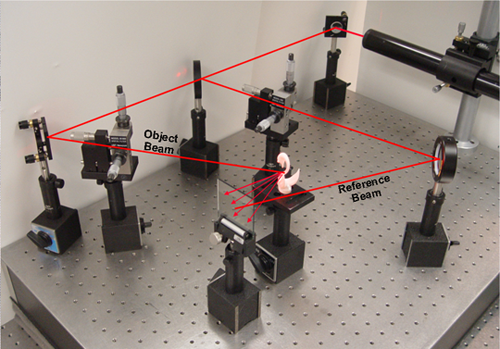Laboratory techniques for observing optical phenomena and quantitative experimental study in geometrical optics, optical interferometry, diffraction, and image processing. (As of Fall 2009, this course replaced OSE 5234L)
Description:
This course will consist of a one-hour lecture and a three-hour laboratory session each week. It is intended to complement traditional class-room lectures provided by a variety of other academic courses in applied optics. Laboratory techniques for observing optical phenomena and quantitative experimental characterization will be emphasized. Proper documentation of experimental observations in a laboratory notebook (complete with witness signatures and recorded dates) will be required.
The students will become familiarized with equipment and techniques commonly used in classical and modern optics laboratories. The students will observe and experimentally study a variety of applied optics phenomena including: aberrations in the image of a point source, diffraction effects of aperture size and shape, diffraction grating behavior, basic interference phenomena, the Fourier transforming properties of lenses, the effects of spatial filtering upon the spatial frequency content of an image. In addition, they will make quantitative measurements of the paraxial properties (cardinal points) of imaging systems, will become familiar with and learn to use a variety of types of interferometers in optical testing applications, and will both record and reconstruct three-dimensional holographic images. Good experimental procedure and physical insight into basic optical phenomena will be emphasized throughout this laboratory course.
Topics:
Category A: Geometrical Optics, Effects of Aberrations, and Optical Testing
- Measurement of Paraxial Properties of a Lens (two weeks).
- Observing and Measuring Chromatic Aberration.
- Third-order Monochromatic Aberrations of a Point Source (two weeks).
Category B: Interference and Diffraction
- Basic Interference (Young’s Interference Experiment, Lloyd’s Mirror, the Newton Interferometer, Three and Four-slit Interference).
- Aperture Diffraction Effects (for various aperture sizes and shapes).
- Diffraction Gratings (spatial and spectral behavior).
- Polarization Effects (Malus’ Law, Brewster’s angle, Fresnel Reflectance Equations).
- Interferometry (Michelson, Twyman-Green, and Point Diffraction Interferometer).
Category C: Fourier Optics, Spatial Filtering, and Holography
- Fourier Transforming Properties of Lenses and Spatial Filtering.
- Holographic Recording and Reconstruction (two weeks).

Laboratory Set-up for Recording a Transmission Hologram